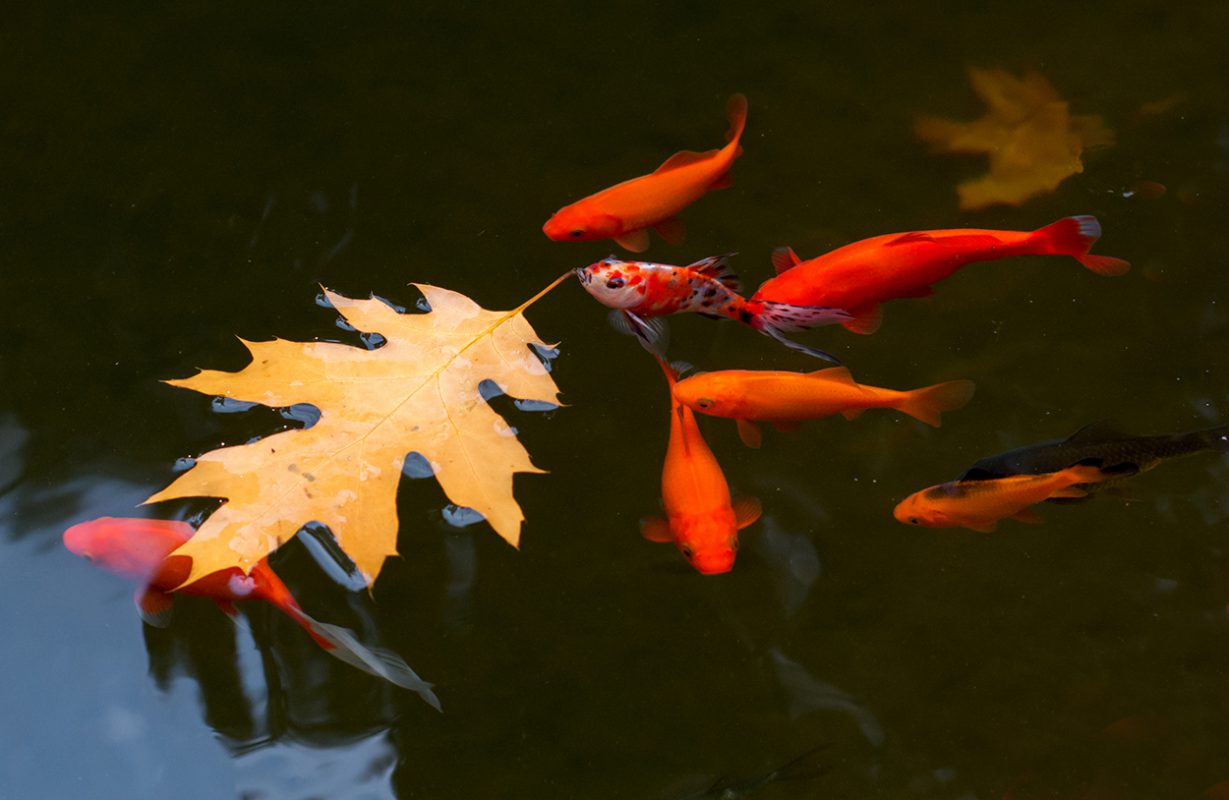The days are drawing in and the temperatures are falling. Autumn is approaching, so now is the time to prepare your pond for the winter. When autumn comes, cleaning and caring for your pond and properly feeding your fish are essential if these are to make it through the winter in good shape. Good pond care also helps you maintain the optimum biological balance in your pond.
The right plant care
To help your garden plants and pond make it through the winter in good shape, you should cut back the plants at the edge of the pond, both by and in the water, plus remove any dead plants and plant matter. When doing this, take care to ensure that pond plants with a cylinder stalk or stem, such as reeds or bulrushes, are only cut back to the surface of the water as a maximum to enable a certain level of gas exchange even when ponds are frozen in the winter. Some plant species are unable to survive the winter and should therefore be removed from ponds and placed in a bucket with sufficient water and, if necessary, a plant substrate. This should then be stored in frost-free conditions over winter.
These precautions are essentially intended to prevent too much plant matter ‘rotting’ in the water or being broken down by microorganisms and thus an excess of organic materials in the water. This would not only release too many nutrients in the water but also result in a thick layer of sludge or sediment over time. This could lead to water turbidity if whipped up plus would provide a source of excessively high nutrient levels in the water, which can cause issues like increased algae growth in spring. You should therefore also keep a close eye on the leaves that are blown or fall into the pond in autumn.
Remove leaves from the pond
Although tree-lined ponds look beautiful in summer, the leaves that drop in autumn are a real nuisance. The brightly coloured autumnal leaves fall into the water and sink to the bottom of the pond where they are broken down by microorganisms. Over time, the aforementioned layer of sediment gets ever thicker and inevitably starts to impair the water quality. In autumn, you should use a net to regularly remove any leaves that have fallen from trees from the surface of the water. In the case of smaller ponds in particular, fitting a leaf net across the surface can save you from having to regularly fish out the leaves.
Remove sediment
Over the course of the year, a layer of sludge or sediment builds up in the deeper parts of the pond, which must be removed before the winter. This can be done quickly using a ‘pond vacuum’. Removing all unnecessary sludge and sediment from your pond is a basic prerequisite for ensuring good water quality over winter – an aspect that is crucial for your fish to remain healthy throughout this chilly season. Additional partial water changes are also important pond care measures when preparing for winter. They too help to prevent poor water quality and an excessively high nutrient content, thereby minimising the risk of prolific algae growth the following spring.

Give technology a break
In late autumn, well before the first frost, all devices and conduits that are neither frost-proof nor protectively housed should be protected against frost damage due to freezing. Water pumps should be removed from the water, cleaned and stored in a frost-free location. Depending on their design, filters should also be made winter-proof or prepared to withstand the winter without issue. The only reason to operate air pumps over winter is if they use air outlets to keep the pond free from ice. These must naturally be positioned so as to be protected from the elements.
There are various options if you want to keep part of your pond free of ice. The use of small water pumps or air pumps with air outlets is particularly effective. You should position these in a frost-proof shallow area so as not to recirculate the water layers and disturb the temperature layering of the water. This is important as, in winter, the ‘warmest’ water layers (where your fish will remain) are located at the bottom of the pond. If, despite your precautions, your pond still freezes in winter, leave it alone. Do not stand on or break the ice as this can be life-threatening for the fish.
Preparing the fish
You also have to prepare your fish for winter. As such, you should start to feed them high-energy foods in autumn so that they can build up sufficient energy reserves. If the water temperature drops below 10°C, you should start feeding your fish Tetra Pond Wheatgerm Sticks as these can be easily digested at low temperatures and help to shorten the non-feeding period.

